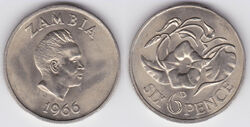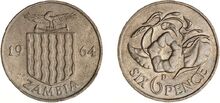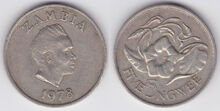- This article is about the coin of the independent Republic of Zambia. For earlier 6 pence coins used in Zambia, see Southern Rhodesian 6 pence coin and Rhodesia and Nyasaland 6 pence coin.
| 6 pence | |
|---|---|

| |
| 1966 coin | |
| General information | |
| Country | |
| Value |
6 pence = ½ shilling = 1⁄40 pound |
| Years |
1964–1966 |
| Measurements and composition | |
| Mass |
2.8 g |
| Diameter |
19.4 mm |
| Thickness |
1.38 mm |
| Composition |
copper-nickel-zinc |
| Appearance | |
| Shape |
round |
| Alignment |
medallic |
| Edge |
reeded |
| Obverse |
|
| Reverse |
Morning glory, value |
| v · d · e | |
The 6 pence coin is a former circulation piece of the Republic of Zambia, issued in two types from 1964 to 1966. With the establishment of the Zambian pound, the initial 6 pence coin was introduced in 1964, during the first year of of President Kenneth Kaunda's (1924–) administration. It was followed only two years later, in 1966, by a second modified coin.
Both pieces were demonetized following the Zambian pound's replacement by the kwacha in 1968. Prior to this, however, the coins held a legal tender face value equivalent to 1⁄40 (0.025) of a pound, and during the 1968 currency changeover, they temporarily remained valid for 0.05 kwacha. For this reason, the designs of the 1966 6 pence were transferred to the first 5 ngwee coin, which was also valued at 0.05 kwacha.
Both pieces were distributed by the Bank of Zambia and struck at the British Royal Mint at Tower Hill, London.
Coins[]
1964 coin[]

1964 coin
Due to growing social pressures in Rhodesia and Nyasaland, the United Kingdom, by an act of the 43rd Parliament, granted independence to its protectorate of Northern Rhodesia in 1964. Soon after, the territory changed its name to the Republic of Zambia, and Prime Minister Kenneth Kaunda was installed as the nation's first President. Upon its independence, Zambia introduced its own pound to replace the previous currency of Rhodesia and Nyasaland. In 1964, the Bank of Zambia commissioned the British Royal Mint to strike the first series of coins for the currency, which consisted of denominations of 6 pence, 1, and 2 shillings. All three pieces were designed and engraved by English sculptor Norman Sillman (1921–2013).
The 1964 6 pence coin is composed of a copper-nickel-zinc alloy, weighs approximately 2.8 grams, and measures 19.4 millimeters in diameter and 1.38 millimeters in thickness. It has medallic alignment and a reeded edge, and like most coins, is round in shape. The rims of both the obverse and reverse are raised and undecorated.
Displayed in the center of the obverse is a simplified version of the coat of arms of Zambia – which consists of a central escutcheon decorated with vertical wavy lines, surmounted by a crossing pickaxe and hoe and an African fish eagle (Haliaeetus vocifer) with outspread wings. The supporters included in the traditional rendition of the arms, along with the ground on which they stand; the symbols of mining, agriculture, and wildlife; and the scroll bearing Zambia's national motto, are all omitted. The Gregorian date of minting, "1964" is engraved horizontally in the middle of the piece, the first two digits separated from the last two by the arms. Inscribed along the bottom periphery of the coin in a counterclockwise direction is the state title "ZAMBIA".
Featured at the top center of the reverse is an illustration of a morning glory (Ipomoea), a species of flowering plant native to portions of Zambia and various other locations worldwide. "6D", identifying a face value of 6 pence, is printed horizontally below the plant. The "D", an abbreviation for the Latin denarii, has historically been used to express amounts in pence in pound-based currencies. Written in a counterclockwise direction along the bottom rim of the piece is the accompanying value "SIX PENCE", the first word separated from the second by the number "6" in the aforementioned inscription.
A total of approximately 3,505,000 examples of the first Zambian 6 pence coin were produced, including 3,500,000 business strikes and a limited 5,000 proofs. Of these, the latter was exclusively included in proof sets along with the 1964 1 and 2 shilling pieces. Because some of these sets have since been broken, though, the proofs have been sold individually as well.
| Mintages | |
|---|---|
| Year | Mintage |
| 1964 | 3,500,000 |
| 1964 Proof | 5,000 |
| Total | 3,505,000 |
1966 coin[]
- See also: Zambian 5 ngwee coin

A 5 ngwee coin, very similar to the 1966 6 pence in appearance
In 1966, nearly two years into the administration of Kenneth Kaunda, the Bank of Zambia contracted the Royal Mint again to produce the second (and final) series of coins for the Zambian pound. Such a series consisted of all of the denominations included in the previous, with the addition of a penny. Norman Sillman was responsible for designing and engraving the obverses of the new 6 pence (pictured above) and 1 and 2 shilling coins; the reverses remained unaltered. The designs of the the 1966 6 pence would later be adapted for Zambia's first 5 ngwee piece, as would the designs of the shilling and 2 shilling pieces for the 10 and 20 ngwee coins, respectively.
The composition and dimensions of the second Zambian 6 pence are identical to those of the original 1964 coin. It is made of a copper-nickel-zinc alloy, and has a mass of 2.8 grams, a diameter of 19.4 millimeters, and a thickness of 1.38 millimeters. The piece bears a reeded edge and has medallic alignment, and is round in shape. Both rims of the coin are raised and undecorated.
Displayed in the middle of the obverse, in place of the coat of arms, is a right-facing bust of President Kenneth Kaunda. The state title "ZAMBIA" is inscribed clockwise along the rim above Kaunda's likeness, while the Gregorian minting date "1966" is written in the opposite direction at the coin's bottom periphery, below the bust.
The reverse of the piece is identical to that of the 1964 6 pence, featuring a morning glory at the top center, with the value printed below as "6D" and "SIX PENCE".
A total of approximately 7,200,060 examples of the 1966 coin were produced, including 7,200,000 business strikes and 60 proofs. The 60 proofs were included exclusively in 30 sets with the penny, shilling, and 2 shilling pieces, with 2 of each coin per set. Business strikes are relatively common, but proofs are considered extremely rare. Currently, Krause's Standard Catalog of World Coins does not include any values for the latter.
| Mintages | |
|---|---|
| Year | Mintage |
| 1966 | 7,200,000 |
| 1966 Proof | 60 |
| Total | 7,200,060 |
References[]
- Numismatic Guaranty Corporation – 1964 Zambia 6 Pence KM# 1, 1966 Zambia 6 Pence KM# 6
- Numista – 6 Pence (1964), 6 Pence (1966)
Zambian pound on the English Wikipedia
| Zambian pound | |
|---|---|
| Banknotes | 10s • £1 • £5 |
| Coins | 1d • 6d • 1s • 2s • 5s |
| Miscellaneous | Bank of Zambia • De La Rue • Penny • Pound • Royal Mint • Shilling |
